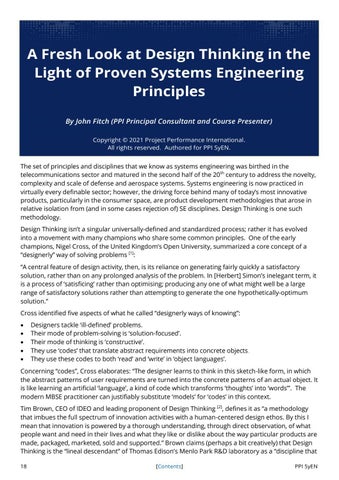A Fresh Look at Design Thinking in the By John Fitch (PPI Principal Consultant and Course Presenter) Light of Proven Systems Engineering Principles A Fresh Look at Design Thinking in the Light of Proven Systems Engineering Principles
By John Fitch (PPI Principal Consultant and Course Presenter) Copyright © 2021 Project Performance International. All rights reserved. Authored for PPI SyEN.
The set of principles and disciplines that we know as systems engineering was birthed in the telecommunications sector and matured in the second half of the 20th century to address the novelty, complexity and scale of defense and aerospace systems. Systems engineering is now practiced in virtually every definable sector; however, the driving force behind many of today’s most innovative products, particularly in the consumer space, are product development methodologies that arose in relative isolation from (and in some cases rejection of) SE disciplines. Design Thinking is one such methodology. Design Thinking isn’t a singular universally-defined and standardized process; rather it has evolved into a movement with many champions who share some common principles. One of the early champions, Nigel Cross, of the United Kingdom’s Open University, summarized a core concept of a “designerly” way of solving problems [1]: “A central feature of design activity, then, is its reliance on generating fairly quickly a satisfactory solution, rather than on any prolonged analysis of the problem. In [Herbert] Simon’s inelegant term, it is a process of ‘satisficing’ rather than optimising; producing any one of what might well be a large range of satisfactory solutions rather than attempting to generate the one hypothetically-optimum solution.” Cross identified five aspects of what he called “designerly ways of knowing”: • • • • •
Designers tackle ‘ill-defined’ problems. Their mode of problem-solving is ‘solution-focused’. Their mode of thinking is ‘constructive’. They use ‘codes’ that translate abstract requirements into concrete objects . They use these codes to both ‘read’ and ‘write’ in ‘object languages’.
Concerning “codes”, Cross elaborates: “The designer learns to think in this sketch-like form, in which the abstract patterns of user requirements are turned into the concrete patterns of an actual object. It is like learning an artificial ‘language’, a kind of code which transforms ‘thoughts’ into ‘words’”. The modern MBSE practitioner can justifiably substitute ‘models’ for ‘codes’ in this context. Tim Brown, CEO of IDEO and leading proponent of Design Thinking [2], defines it as “a methodology that imbues the full spectrum of innovation activities with a human-centered design ethos. By this I mean that innovation is powered by a thorough understanding, through direct observation, of what people want and need in their lives and what they like or dislike about the way particular products are made, packaged, marketed, sold and supported.” Brown claims (perhaps a bit creatively) that Design Thinking is the “lineal descendant” of Thomas Edison’s Menlo Park R&D laboratory as a “discipline that 18
[Contents]
PPI SyEN




